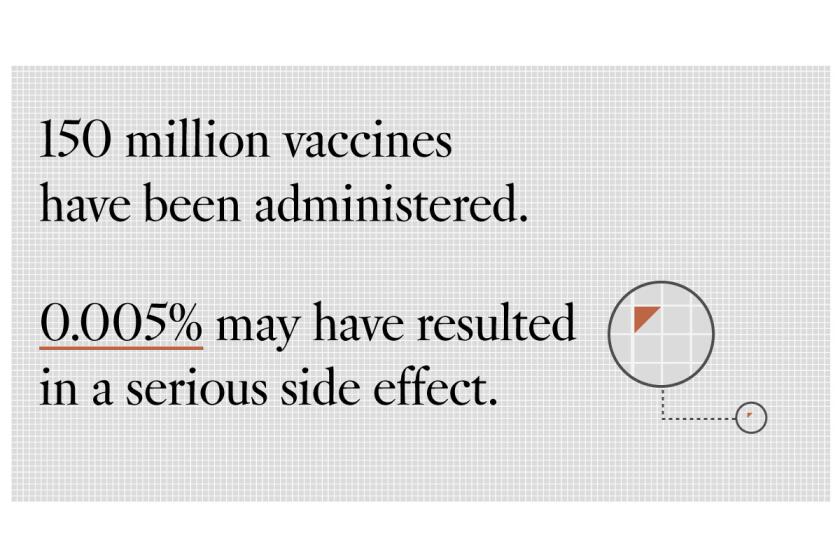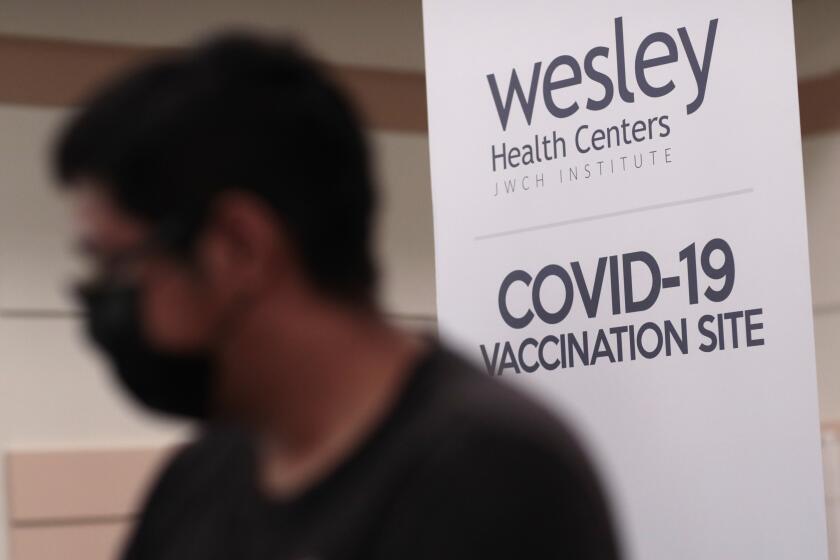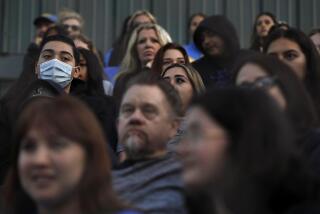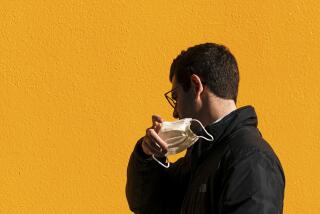Just 5 states account for nearly half of all new U.S. coronavirus infections
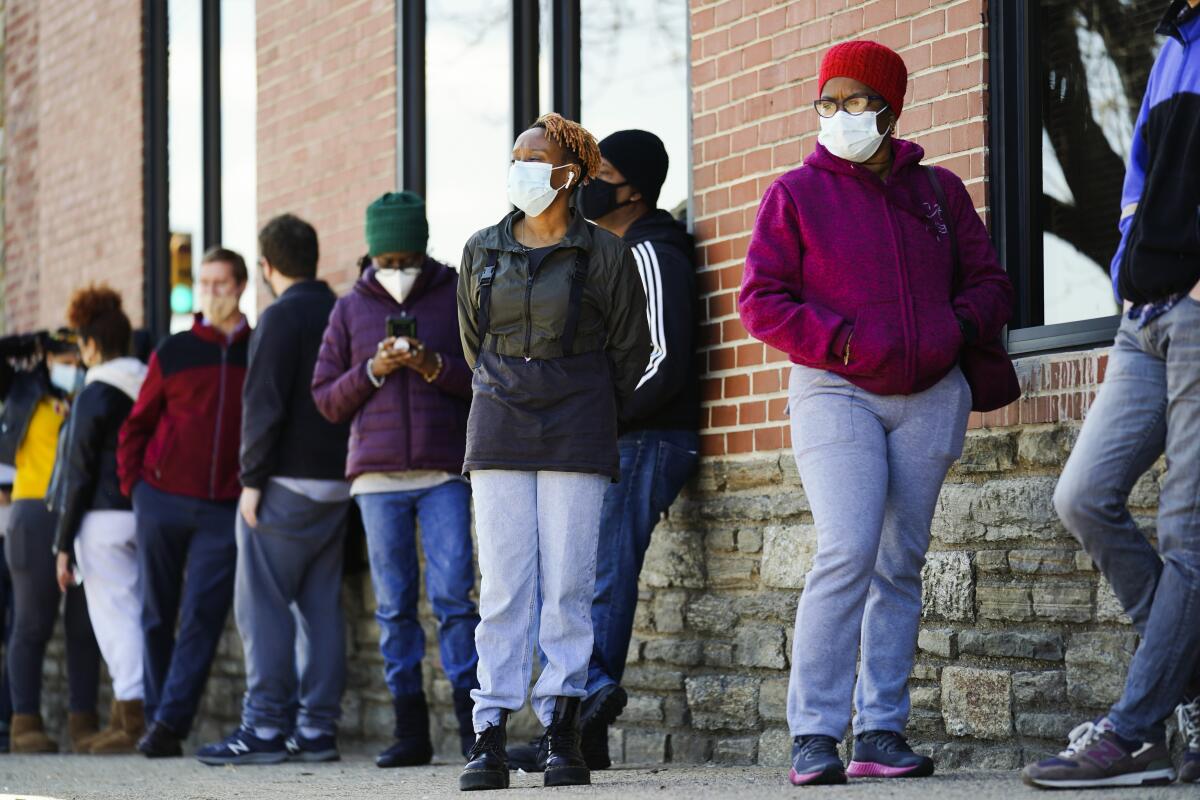
Nearly half of new coronavirus infections nationwide are in just five states — a situation that is putting pressure on the federal government to consider changing how it distributes vaccines by sending more doses to hot spots.
New York, Michigan, Florida, Pennsylvania and New Jersey together reported 44% of the nation’s new COVID-19 infections, or nearly 197,500 new cases, in the latest available seven-day period, according to data compiled by Johns Hopkins University. Total U.S. infections during the same week numbered more than 452,000.
The heavy concentration of new cases in states that account for 22% of the U.S. population has prompted some experts and elected officials to call on the Biden administration to ship additional vaccine doses to those places. So far, the White House has shown no signs of shifting from its policy of dividing vaccine doses among states based on population.
Sending extra doses to places where infection numbers are climbing makes sense, said Dr. Elvin H. Geng, a professor in infectious diseases at Washington University in St. Louis. But it’s also complicated. States that are more successfully controlling the coronavirus might see less vaccine as a result.
“You wouldn’t want to make those folks wait because they were doing better,” Geng said. “On the other hand, it only makes sense to send vaccines to where the cases are rising.”
The spike in cases has been especially pronounced in Michigan, where the seven-day average of daily new infections reached 6,719 cases Sunday — more than double what it was two weeks earlier. Only New York reported higher case numbers. And California and Texas, which have vastly larger populations than Michigan, are reporting fewer than half of Michigan’s number of daily infections.
The existence of a coronavirus variant containing two worrisome mutations, first discovered in India two weeks ago, is confirmed in California.
Though Michigan has seen the highest rate of new infections in the last two weeks, Gov. Gretchen Whitmer has said she does not plan to tighten restrictions. The Democrat has blamed the surge on pandemic fatigue, which has people moving about more, as well as more contagious variants.
“Taking steps back wasn’t going to fix the issue,” Whitmer said as she got her first vaccine dose Tuesday. “What we have to do is really put our foot down on the pedal on vaccines” and urge people to wear masks, maintain social distance and wash their hands.
Whitmer got her shot the day after Michigan expanded eligibility to everyone 16 and older. She asked the White House last week during a conference call with governors whether it had considered sending extra vaccine to states battling coronavirus surges. She was told that all options were on the table.
In New York, vaccination appointments are still challenging to get. Mayor Bill de Blasio has publicly harangued the federal government about the need for a bigger vaccine allotment almost daily, a refrain he repeated when speaking to reporters Tuesday.
“We still need supply, supply, supply,” De Blasio said, before adding: “But things are really getting better.”
Questions about COVID-19 vaccines’ safety have led to hesitancy for some Americans. Experts say there is almost zero cause for concern.
On the state level, Gov. Andrew Cuomo has not called publicly for an increase in New York’s vaccine allotment, even as cases ticked up in recent weeks and the number of hospitalized people hit a plateau.
In New Jersey, where the seven-day rolling average of daily new infections has risen over the past two weeks, from 4,050 daily cases to 4,250, Gov. Phil Murphy said he was constantly talking to the White House about demand for the vaccine, though he stopped short of saying he was lobbying for more because of the state’s high infection rate.
Vaccine shipments to New Jersey were up 12% in the last week, Murphy said Monday, though he questioned whether that was enough.
“We know we’re going up, but are we going up at the rate we should be, particularly given the amount of cases we have?” Murphy said.
New coronavirus variants are clearly one of the drivers in the increase, said Dr. Kirsten Bibbins-Domingo, chair of the department of epidemiology and biostatistics at UC San Francisco. Failure to suppress the rise in cases will lead to more people getting sick and dying, she said, and drive increases in other parts of the country.
“More vaccine needs to be where the virus is,” Bibbins-Domingo said, adding that people should get over the “scarcity mind set” that has them thinking sending more vaccine to one place will hurt people elsewhere.
In Florida, relaxed safeguards during a busy spring break season likely helped spread virus variants, said University of South Florida epidemiologist Jason Salemi. The state’s seven-day average of daily new infections has exceeded 5,400, an increase of 20% in the last two weeks.
Although many new infections appear to be among younger people, Salemi said he’s worried about Florida’s seniors. About 78% of residents age 65 and older have received at least one vaccine dose, but roughly 1 million more still have not gotten any shots.
“We seemingly have the supply,” Salemi said. “Are these people not planning to get vaccinated?”
California continues to buck the COVID-19 spring surge. But are there causes for concern?
Talk of sending extra shots to some states comes at a time when the number of daily infections in the U.S. has fallen dramatically compared with a January spike following the holiday season. However, the seven-day average of daily infections has been rising slowly since mid-March.
The five states seeing the most infections stand out. As of Tuesday, 31 U.S. states were reporting seven-day averages of fewer than 1,000 new daily cases.
White House coronavirus coordinator Jeff Zients said Tuesday that more than 28 million doses of COVID-19 vaccines will be delivered to states this week. That allocation will bring the U.S. total to more than 90 million doses distributed in the last three weeks.
The news came as Biden announced that all adults would be eligible to receive a vaccine by April 19.
About 40% of U.S. adults have now received at least one COVID-19 shot, according to the Centers for Disease Control and Prevention. About 23% of American adults have been fully vaccinated — including more than half of Americans 65 and older.
More to Read
Sign up for Essential California
The most important California stories and recommendations in your inbox every morning.
You may occasionally receive promotional content from the Los Angeles Times.
